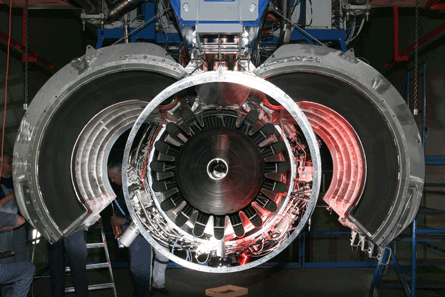Russia's civil presence at this year's Paris air show will be dominated by Sukhoi's regional Superjet 100, the aircraft being viewed either as representing a revival of the country's ailing airliner industry or something of a last stand against a Western onslaught.
Ninety-eight Superjets are claimed as firm orders by the Komsomolsk-based airframer, but the programme is having to battle not only the current economic crisis, but also the fall-out from last year's fuel-price surge that decimated the Russian airline sector.
"Certainly the programme can't stay aside of the present developments that are taking place in the country," says Sukhoi director general Mikhail Pogosyan. "The restructuring of the airline industry is going rather painfully, with greater damage to the smaller carriers."
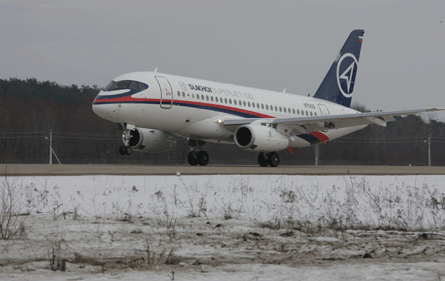 |
|---|
© Marina Lystseva |
Two of Sukhoi's customers for the Superjet - the airline alliance AirUnion and the Khabarovsk-based carrier Dalavia, which together had committed to 21 aircraft - became victims of the crisis.
But Pogosyan is optimistic that the new Russian carrier Rosavia, which has lately been emerging from the remnants, will eventually pick up the Superjet slot positions previously held by the airlines. "We are in contact with Rosavia and they are quite positive on Superjet 100 perspective in their future fleet," he says.
REGIONAL COMPLEMENT
The Superjet is billed as the regional complement to the Antonov An-148, the high-wing twinjet that flew at Le Bourget in 2007, when the French capital last opened the gates to its international air salon.
Confidence prevailed in the civil aviation industry that year, and Sukhoi appeared poised to offer a serious Russian competitor, the first in years, in its bid to take a share of the regional market.
Although the programme has slipped by about two years from its original projection of a first flight in mid-2006, Pogosyan says the Superjet line has developed momentum. Sukhoi is concentrating its efforts on securing Russian certification for the twin-engined aircraft before the end of this year, and delivering the first example to its airline customers.
Sukhoi's test regime involves the first six airframes, numbers 95001 to 95006. The first flying prototype, 001, took to the air in May last year, followed in December by the second flight-test jet, 003.
Both of the remaining flight-test airframes - numbers 004 and 005 - were, at the end of May, in the final assembly shop with the first serial production aircraft, number 007.
Sukhoi says 004 has been fitted with all its systems and has one of its PowerJet SaM146 engines, with the other heading for the "podding" shop at Komsomolsk. Pogosyan says the aircraft is shortly to begin pre-flight ground testing - with engineers checking systems interaction and performing engine runs - with a view to its getting airborne at the end of June. The final flight-test aircraft, 005, is undergoing systems fitting at the final assembly station.
The static airframe, 002, is being tested for ultimate load and showing "very positive" results, says Pogosyan, while airframe 006 is being prepared for fatigue testing in Novosibirsk."Our main goal now is to monitor the concurrency of the certification processes: engine certification, aircraft certification and delivery of software," he adds. "We are intensifying and increasing the productivity of the test flights."
Sukhoi performed long-distance flights with aircraft 001 and 003 in March, transferring them to Moscow ahead of a five-day series of in-flight icing trials on the Archangel-Murmansk route.
"So far the two aircraft have successfully completed some of the complicated missions - flutter safety testing and natural icing - and are well advanced with high angle-of-attack tests," says Pogosyan.
By taking advantage of windtunnels with ice-imitation features, the airframer has been able to reduce the number of scheduled natural icing flights from 18 to five. Similarly, the results of engineering simulations have allowed Sukhoi to cut from 25 to 15 the number of flutter test flights, Pogosyan says, while still achieving the required performance and obtaining the necessary data for certification.
While the first two prototypes will be used to evaluate and verify capabilities and general flight performance, he says the other two flight prototypes, 004 and 005, will be "more 'avionics' and 'passenger' dedicated".
In mid-April, with the two prototypes having logged about 140 rotations between them, test pilots from the European Aviation Safety Agency carried out familiarisation flights on the Superjet ahead of a certification campaign to gain EASA approval. Sukhoi claims the pilots' impressions were that the jet was comfortable and "easy to fly".
Production is under way on the first 13 serial aircraft. Initial serial production is focused on a batch of four jets - numbers 007 to 010 - of which two are destined for Aeroflot and two for Armavia.
Fuselage assembly is complete for 007 and 008, and wing mating on aircraft 007 is in progress. Aircraft 009 is still having its fuselage assembled, aircraft 010 is going through section assembly, while the others are at various preliminary manufacturing stages. There are "no defined plans" for a possible sale of the flying prototypes.
While Aeroflot was originally identified as the first in line to receive the Superjet, there are increasing indications that Armavia could instead be the initial recipient, owing to a less-demanding configuration for its aircraft. During a visit to Yerevan on 16 May, Russian vice-premier Sergei Ivanov said the airline would receive the Superjets at the end of 2009 or beginning of 2010. Testing over Armenian mountain terrain is to take place in July.
Sukhoi has disputed pessimistic forecasts from Russia's new umbrella aerospace holding company United Aircraft, which heavily cuts its planned output of Superjets from 236 to 74 by 2012, part of an overall production climb-down to 118 regional aircraft. The balance will comprise An-148s. Original plans had called for production of 430 regional, mid-sized and long-haul aircraft over the next four years.
Despite the downbeat outlook from United Aircraft, Pogosyan believes the Superjet will ultimately benefit from the restructuring of Russian manufacturing. "I think that there's a wrong perception of the processes that are going on in the industry," he says.
"For years the industry was dispersed and unlevelled. In Russia, consolidation is badly required to optimise the industrial resources and to allocate funding wisely for the sake of the ultimate strategic goal, which is to produce globally competitive products. In this context the Superjet 100 programme may only win, as it will be easier to attract the overall industrial resources required."
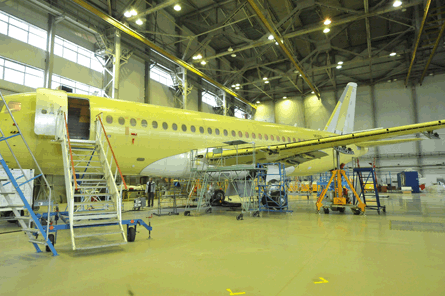 |
|---|
© Sukhoi |
PowerJet, the Franco-Russian venture developing the Superjet's engines, admits that the aircraft programme is having to cope with economic pressures, but is nevertheless confident over its prospects.
Chief executive Jean-Paul Ebanga says the indications from Russia are that the Superjet is regarded as a priority project, a "positive" sign given the problems faced by the country's air transport sector.
There has been no requirement, so far, for PowerJet to cut its activity or shed personnel, he says. Ebanga adds that funding is still in place: "So far the financing for the activity has been there."
But he adds: "This is reality and it affects all the players in the market. As any company is doing when it's being hit by heavy winds, we need to take proactive action to cope with reality. PowerJet's shareholders are already dealing with that."
SCALE-BACK ACTION
Ebanga adds: "Even though times are tough and even if scale-back action has to be taken, the programme will move forward. We are managing the situation tightly; we can't allow any drift."
PowerJet's SaM146 is designed to cover a range of thrust requirements, from 13,500-17,500lb (60-78kN) for regional aircraft in the 70- to 120-seat range, allowing the single engine to bridge the whole Superjet family.
Snecma is responsible for "hot" sections - the core, the accessory drive and control system - while Saturn handles the fan, low-pressure compressor and low-pressure turbine.
The French manufacturer has taken advantage of its CFM International CFM56 experience, but the SaM146's architecture is designed to be simpler, with a 20% reduction in the number of parts.
It features a 1.22m (48.2in) fan with 24 three-dimensional titanium blades, a three-stage low-pressure compressor, followed by a six-stage high-pressure compressor - which PowerJet claims is three fewer than competing powerplants. The manufacturer adds that the initial stages of the high-pressure compressor use blisks to reduce fretting and protect against foreign object damage.
The high-pressure turbine is single stage to reduce weight and parts, and is followed by a three-stage low-pressure turbine.
Ebanga says that, following the second Superjet joining the test-flight programme, development of the SaM146 this year concentrated on subjecting the engine to a high-intensity test regime to meet the certification schedule.
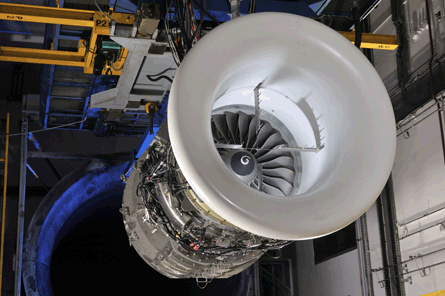 |
|---|
|
© Powerjet |
The engine has accumulated more than 3,200h of tests, of which more than 1,100h have been performed in flights, either with the two operating prototype airframes or on the Russian Gromov Flight Institute's Ilyushin Il-76LL testbed, which has a SaM146 fitted to the left inboard position.
"In terms of the number of hours, the bottom line is that the performance of the engine is really good," says Ebanga. "Not only the performance in itself, but also its behaviour in terms of reliability. These are the kinds of flights which are very stressful for the engines. The pilots are changing altitude and pushing the throttle, not like the situation in revenue service. So not only is the number of hours high, but they're done under stressful conditions. And the results are very positive."
Three types of SaM146 are being manufactured: development engines for basic testing, compliance engines for the flying Superjet prototypes and serial production powerplants.
PowerJet has six development engines running and two more are to be delivered this summer. These will be used for the key block tests, says Ebanga, whereby the engine is exposed to specific cycling runs.
Four compliance engines had been supplied for the two airframes flying as of mid-May and Ebanga says another pair, for the third prototype, should be delivered "in the short term".
The fourth batch of compliance engines is on the line and Ebanga says: "We've already initiated production of parts in line to supply the first serial engine."
Transport of the first two Superjets to Moscow has enabled the first examination of the SaM146 during long cruise. "Everything works fine," claims Ebanga. He adds that the icing tests in Archangel-Murmansk, including flights over the ocean in real conditions, have proven "very useful in understanding the way the engine behaves".
The SaM146 still needs to undergo a new phase of endurance testing as well as trials for hail resistance and further ingestion testing. PowerJet has yet to undertake detailed analysis of the engine's fuel-burn, but is promoting a specific fuel consumption of 0.629lb/h/lb (17.8mg/Ns) for both the low- and high-thrust-rating variants. It points out the weight saving from the aluminium casing and simplified architecture, and says all critical parts of the engine are designed to cut fuel burn.
COLD-WEATHER TRIALS
Ebanga says the detailed fuel-burn assessment falls later in the schedule so the manufacturer can prioritise testing such as cold-weather trials in the winter season. "If you miss the winter window, you're dead [during the summer]," he says.
But PowerJet is confident that it will meet economic targets, says Ebanga: "We've done so many flight hours and we didn't notice anything wrong with the fuel consumption. If anything had been abnormal in the consumption, we'd have noticed."
The SaM146, says PowerJet, is based on the "best compromise" between performance and operating costs. Life-limited parts are designed for an on-wing life of 20,000 cycles. The manufacturer claims Superjet operators will be able to perform an engine change in under 2h and change line-replaceable units in 30min.
PowerJet is aiming for reliability "on a par" with that of the CFM56, with an in-flight shutdown rate of 0.006 per 1,000 flight hours. But it is also establishing a worldwide support network and will offer carriers a range of engineering and repair services under by-the-hour agreements.
"So far all the certification tests we've done have been successful, and we are contemplating finalising this before the end of this year," says Ebanga. "But I want to keep myself humble. We need to be focused."
Irrespective of its engine's heritage, and an assortment of North American and European equipment suppliers, the Superjet has yet to prove it can overcome perceptions and prejudices associated with Soviet-era aircraft. Superjet International, the company created to market the aircraft to customers outside Russia, is yet to score the convincing Western order that would establish Superjet as a player in the cut-throat regional jet sector.
But Superjet International vice-president of sales finance James Beamish is optimistic. He says: "One of the things that surprised me personally was to find out what high brand value the Sukhoi name carries with regional carriers in the USA. Operators look for two things: dispatch reliability and low monthly cash cost. Everything else is secondary."
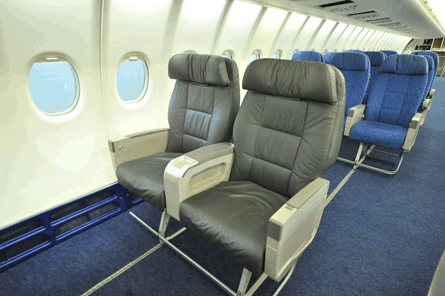 |
|---|
© Sukhoi |
Customer queries over these aspects of the Superjet are "reasonable", he says, because Sukhoi is presenting a new engine, new airframe and a new support structure.
"Certainly the current economic climate is not the best for us. But our competitors are in a relatively more difficult position as they are having to deal with order cancellations and deferrals," adds Beamish.
Export credit agency-backed funding is the only price-competitive financing open to the programme, given the market and the emerging status of the Superjet, but Beamish says: "This isn't something we are ashamed of - this is simply the environment we have. We don't believe that there will ever be an absence of bank uptake on export credit agency-backed debt."
He says the company is expecting a "tougher time" than its rivals because Embraer and Bombardier benefited respectively from Brazilian and Canadian governmental subsidy programmes that became the centre of a bitter and prolonged World Trade Organisation dispute.
INTERNATIONAL TEAM
"We know the challenges, but we have the advantage of a clean sheet of paper to start from," adds Beamish. "The team is integrated and international and has a blend of keen young people and experienced professionals from airlines, MROs and OEMs."
Sukhoi is claiming three Western customers for 35 aircraft: ItAli Airlines with 10, five for Swiss finance firm AMA, and 20 for an unidentified customer, widely thought to be Icelandair Group. First Western deliveries will begin in the second half of 2010, by which time Superjet International is hoping the air transport market will have started recovering.
Beamish says that Superjet International is pursuing "several campaigns" and hopes to have a "high-profile" Western customer by the end of this year.
Russian trade and industry minister Viktor Khristenko hinted in April, following a meeting with the French ambassador to discuss aerospace co-operation, that a "French carrier" could become an "important user" of the aircraft, and the minister reinforced this suggestion in May.
Khristenko added that the Superjet project and Russia's involvement with Airbus were a "priority" for the government and it would "do everything possible" to ensure that they were not affected by the current climate.
"The global economic crisis has bumped up some costs [which are] dependent on the increase in currency," says Pogosyan. "But this is not fatal for the programme."
All Superjet orders have been for either the baseline or long-range version of the 95-seat model. Although the type was conceived as a three-aircraft family, the 60-seat variant was dropped at an early stage and there is little evidence of strong interest in the 75-seat version. Sukhoi is leaning instead towards offering a stretched Superjet with 115-120 seats.
"There is a definite perspective to move towards the stretched version having evaluated the resources we can allocate, the scope of additional research and development, and the targeted market niche to bring forward a successful product," says Pogosyan.
"When the passenger traffic has fallen, we have to be very precise and careful. Now we're concentrating on preparing to launch into operation a 95-seater and make a good aircraft in service of our customers," he adds.
- All the latest news, images and video from the Paris Air Show
- All the latest Sukhoi Superjet news, images and video
Source: Flight International














